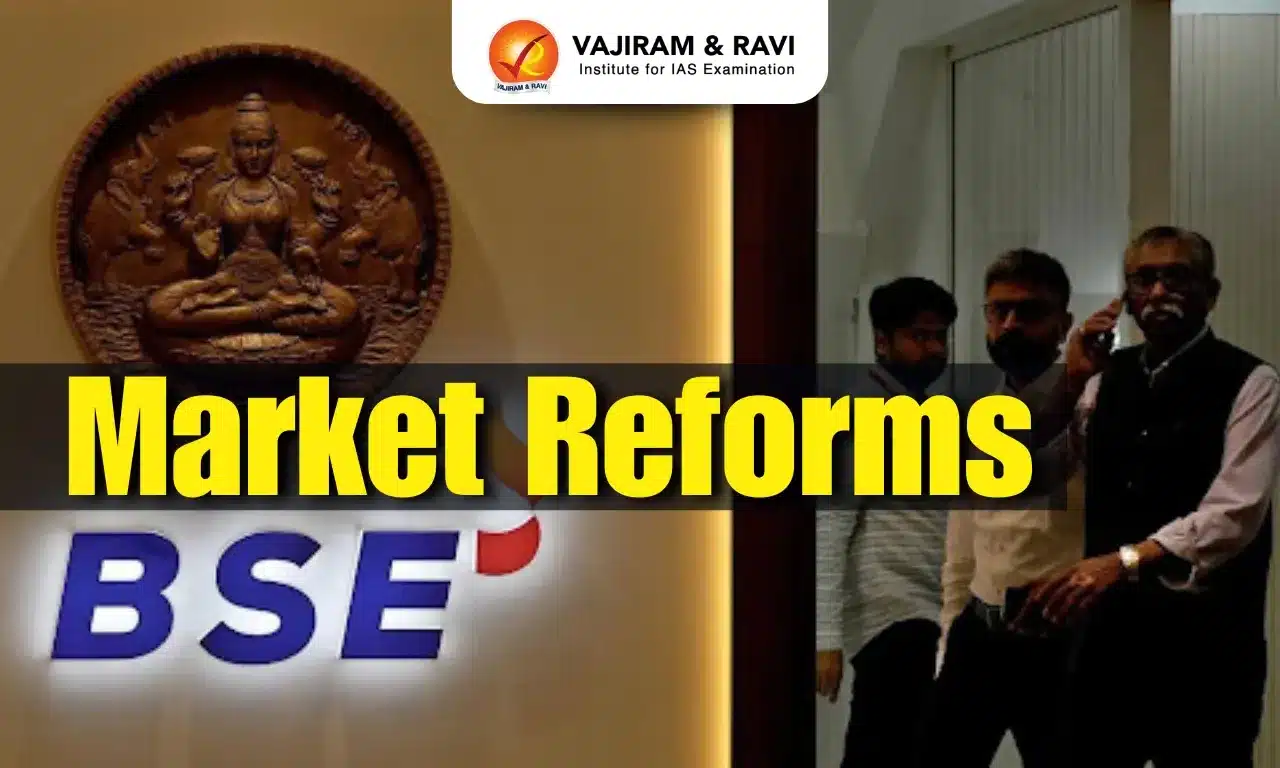SEBI has introduced various important market reforms to strengthen India’s capital markets.
Market Reforms Latest News
SEBI has announced major market reforms, including the SWAGAT-FI framework for foreign investors, relaxed IPO dilution norms, and stronger governance measures for exchanges.
Introduction
The Securities and Exchange Board of India (SEBI) has announced sweeping reforms aimed at enhancing foreign investment inflows, easing IPO norms for large companies, and strengthening governance within market infrastructure institutions.
These measures come at a time of heightened global economic uncertainty, with foreign portfolio investors (FPIs) pulling out significant capital due to U.S. tariffs, rich valuations, and weak corporate earnings.
The reforms are expected to reinforce India’s reputation as a competitive and investor-friendly market while balancing investor protection and regulatory compliance.
Foreign Investor Access through SWAGAT-FI
One of the most significant announcements is the introduction of the Single Window Automatic & Generalised Access for Trusted Foreign Investors (SWAGAT-FI) framework.
Scope: It covers FPIs and Foreign Venture Capital Investors (FVCIs) from categories such as sovereign wealth funds, central banks, insurance companies, pension funds, and regulated retail funds.
Features:
A unified 10-year registration and KYC cycle (up from 3 years).
Exemption from the 50% cap on aggregate contributions by NRIs, OCIs, and resident Indians.
Simplified compliance and reduced paperwork through the India Market Access portal, launched alongside SWAGAT-FI.
Impact: The move aims to restore investor confidence amid record foreign outflows of nearly Rs. 63,500 crore since July 2025.
Relaxed IPO Norms for Large Companies
SEBI has also eased the minimum public offer (MPO) and public shareholding requirements for large issuers:
Companies with Rs. 1-5 lakh crore market cap must now offer 2.75-2.8% of their post-issue market cap, compared with 5% earlier.
MPO size threshold raised to Rs. 6,250 crore for very large issuers.
Public float timeline: Firms with less than 15% public shareholding at listing now get 10 years (up from 3–5 years) to meet the 25% minimum requirement.
Anchor Investor rules:
Anchor quota raised to 40% from one-third, including allocations for mutual funds, life insurers, and pension funds.
Minimum allotment size set at Rs. 5 crore.
Broader anchor investor participation permitted.
These reforms are particularly beneficial for mega-IPOs, where immediate high dilution often deters promoters.
Strengthened Governance in Market Infrastructure Institutions
SEBI has introduced structural changes to improve the governance of stock exchanges and clearing corporations:
Two executive directors will head separate verticals – critical operations (trading, clearing, settlement) and regulatory compliance (risk management, investor grievances).
Defined roles for managing directors and key managerial personnel, enhancing accountability and succession planning.
This comes in the wake of past governance concerns in major exchanges, where lapses undermined market trust.
Mutual Fund and Retail Investor-Centric Reforms
To deepen financial inclusion, SEBI has announced measures to improve retail participation, especially from smaller towns and underrepresented groups:
Exit load in mutual funds has been reduced to 3% from 5%.
Distributor incentives revised to promote investments from beyond top-30 cities (B-30) and to encourage participation by women investors.
Enhanced disclosure and compliance norms for related-party transactions (RPTs), with thresholds linked to company turnover.
Significance of the Reforms
For India’s markets: They provide flexibility for large companies tapping equity markets and simplify investment processes for trusted foreign players.
For global competitiveness: SWAGAT-FI positions India as a stable long-term investment hub amid global capital volatility.
For retail investors: The focus on smaller cities and women investors aligns with India’s push for inclusive financial growth.
Market Reforms FAQs
Q1. What is the SWAGAT-FI framework introduced by SEBI?+
Q2. How have IPO norms been relaxed for large issuers?+
Q3. What changes were made for anchor investors in IPOs?+
Q4. What governance reforms were introduced for stock exchanges?+
Q5. What steps has SEBI taken for mutual fund investors?+
Tags: mains articles market reforms upsc current affairs upsc mains current affairs
Previous Article
PM Modi’s Manipur Visit: Key Challenges in the Conflict-Hit State
Vajiram Editor
At Vajiram & Ravi, our team includes subject experts who have appeared for the UPSC Mains and the Interview stage. With their deep understanding of the exam, they create content that is clear, to the point, reliable, and helpful for aspirants.Their aim is to make even difficult topics easy to understand and directly useful for your UPSC preparation—whether it’s for Current Affairs, General Studies, or Optional subjects. Every note, article, or test is designed to save your time and boost your performance.
Related Posts
Courses

